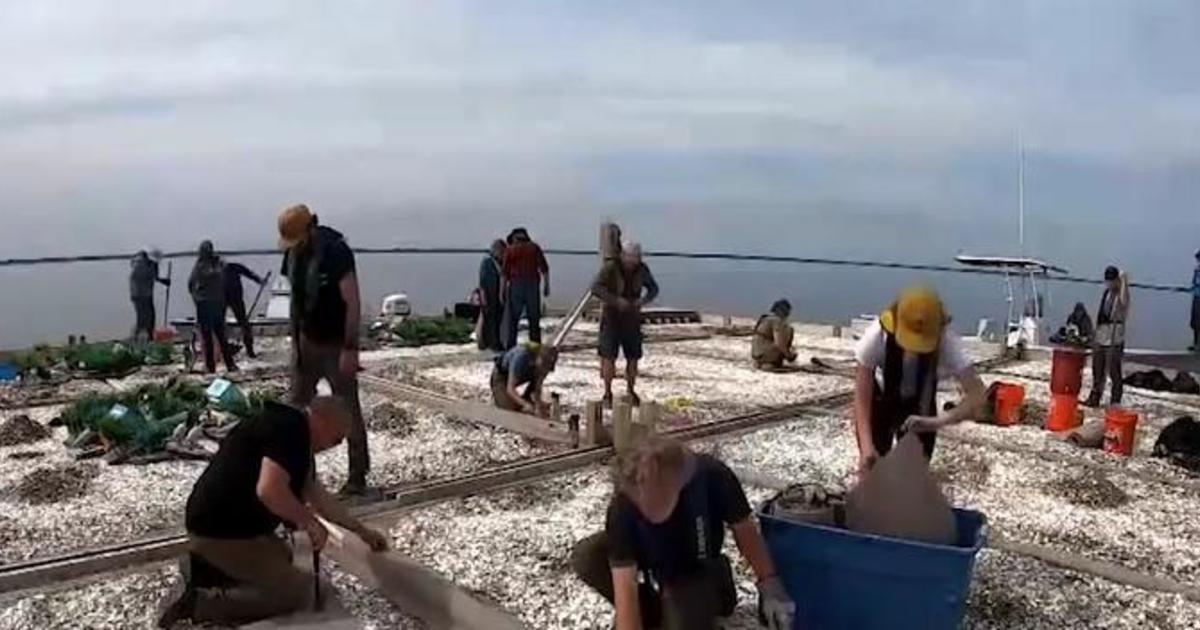Dinosaur Bone Found By Archaeological Team In Md.
By E.B. FURGURSON III
The Capital of Annapolis
EDGEWATER, Md. (AP) -- The artifact-rich, multilayered Pig Point site being worked by Anne Arundel County's archaeological team for yet another season has turned up more unusual finds -- a dinosaur bone and a dog burial site.
The dinosaur bone was found during last season's dig along the banks of the Patuxent River overlooking Jug Bay in south county, and later identified as technicians pored over the pickings at the county's archaeological lab at Historic London Town and Gardens.
The dog burial site was discovered just weeks ago as this season's dig got under way near the original upper tract. Three
years ago, the team found evidence of a series of wigwams indicating a settlement over hundreds of years.
Al Luckenbach, the county's archaeologist, said he immediately identified the petrified dinosaur bone because he had seen similar bones years ago.
"They were building (in) an area northwest of BWI (Thurgood Marshall) Airport and were finding huge pieces of petrified wood and bone," he said. "I picked up a piece of dinosaur backbone, and more."
He said staff members sometimes do not realize what they have discovered until it's cleaned up in the lab.
"We dig up a lot of stuff over the (summer) season and then go into the lab over the winter and start washing it up. We didn't realize we had it until it turned up this winter," he said.
A lab worker showed it to him and Luckenbach said, "Oh, that is a ferruginous sandstone dinosaur backbone from the Arundel Formation" -- only because he had seen one many years ago.
The Arundel Formation is a huge clay deposit stretching between Washington, D.C., and Baltimore, running roughly along Route 1.
Part of the formation is made up of iron-bearing sandstone, which appears closest to the surface in the Laurel area off Route 1 in Prince George's County, where it is known as the Muirkirk Deposit. The deposit was the site of iron mining operations stretching back into the early 19th century, and troves of fossilized animal and plant remains have been found in it.
Some of the first dinosaur bones, believed to be 110 million years old, were found there. These include some of the earliest finds in the Smithsonian Institution's dinosaur collection.
In the Cretaceous Period, some 100 million years ago, the area was a delta, with rivers that meandered in wide bends. Scientists believe flooding deposits bones and plant matter in oxbow lakes formed when large bends in a river are cut off, creating a lake.
Luckenbach first thought a Native Americans had picked up the dinosaur bone near the Muirkirk area and brought it to Pig Point.
But after further investigation, he thinks the bone was picked up along with similar-sized rocks and used as a cobble, or pot boiler, for cooking.
"The Native Americans cooked in clay pots. But if you put a clay pot on the fire it would crack as it heated up," he said.
"So they would put their meat, vegetables and water in the pot, then heat up these small rocks in the fire and drop them in the pot to cook their food," Luckenbach said.
He said archaeologists find pot remnants with similar stones, or pot boilers, in them.
The dog skeleton was found on the upper tract of the Pig Point site.
"The dog was elderly, its teeth were quite worn," Luckenbach said. Many of the dog's bones could not be recovered, but most of the skull was preserved. "We have not run a C14 (carbon isotope) test on it to determine its age, but we estimate the dog was buried in the Late Woodland Period, roughly from 1000 to 1300 A.D."
Dogs were the only domesticated animals Native American tribes had, but few dog burials from the period have been found in Maryland.
The animals were used for hunting and as guard dogs.
"Anything approaching the village, the dogs would provide a good warning," Luckenbach said.
Sometimes dogs were sacrificed, perhaps to go along with their masters into the afterlife.
"There was a lot of religious ritual and mythology associated with dogs," he added. "Dogs had a special place in the lives of Native Americans."
He doesn't know whether the dog died of old age or was sacrificed, but it was buried a few feet from a wigwam, "perhaps
to guard the place from the next life," Luckenbach said.
He said it was heartening to see man's best friend from 900 years ago. "He had a special burial."
(Copyright 2012 by The Associated Press. All Rights Reserved.)



